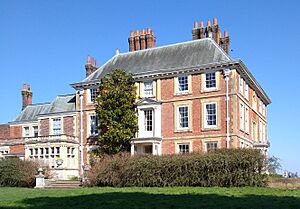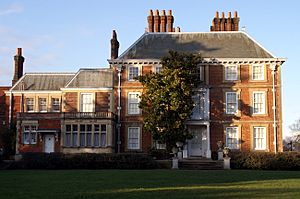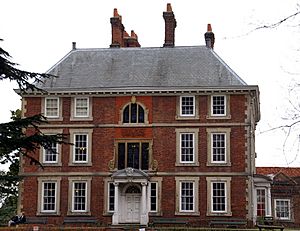Forty Hall facts for kids
Quick facts for kids Forty Hall |
|
|---|---|

Forty Hall from the south
|
|
| Type | Manor House |
| Location | Forty Hill |
| Area | Enfield |
| Built | 1620s |
| Owner | London Borough of Enfield |
|
Listed Building – Grade I
|
|
| Official name: Forty Hall | |
| Designated | 12 March 1951 |
| Reference no. | 1294469 |
| Lua error in Module:Location_map at line 420: attempt to index field 'wikibase' (a nil value). | |
Forty Hall is a beautiful old house built in the 1620s. It is located in Forty Hill in Enfield, which is in north London. This historic house is now a museum. It is managed by the London Borough of Enfield. The land around the house also holds the remains of an even older palace called Elsyng Palace.
Where is Forty Hall?
Forty Hall is in the northern part of Enfield. This is the most northern area of London. The house and its gardens sit on top of Forty Hill. This hill is a flat area of gravel. It is higher than the River Lea to the east. It is also higher than the Turkey Brook valley to the north and west.
The park slopes down into the valley. Here you can find old ponds. A part of the old New River used to form a border for the estate. However, this river has since been moved further east. To the north of Forty Hall are Whitewebbs and Myddelton House. The road to the east was once the main way to get from Enfield to Waltham Cross. Now, traffic uses the A10 instead.
The History of Forty Hall
Forty Hall was built between 1629 and 1632. Many people believe it was built by Sir Nicholas Rainton. He was a very rich London merchant. He was also the Lord Mayor of London from 1632 to 1633. The Lord Mayor is the leader of the City of London. However, some older records suggest it might have been built by Sir Hugh Fortee. Sir Nicholas Rainton then bought it from him.
For a long time, people did not fully understand the house's history. It was built in the 1620s. But from the outside, it looks more like a house from the 1700s. Experts studied the house for the Enfield council. They found that a "clever artisan builder" likely designed it. It was probably not a famous architect like Inigo Jones.
The original house was square. It did not change much in the 1600s. Only a small part was added to the northwest in 1636. In 1640, Sir Nicholas Rainton was put in prison. This happened because he refused to help King Charles I get a loan. Sir Nicholas died in 1646 when he was 77 years old. He was buried at St Andrew's Church in Enfield.
After his death, the house went to his great-nephew, also named Nicholas. He made the estate bigger. He bought and then took down the nearby Elsyng Palace in 1656. In 1696, the hall went to John Wolstenholme. He made big improvements to the house. He might have done this after a fire. He also planted the long path of trees.
In 1740, Eliab Breton became the owner. He changed the ground floor of the house. Later owners included Edmund Armstrong (in 1787) and James Meyer (in 1799). The Meyer family built the nearby Jesus Church in 1835.
In 1894, Henry Carrington Bowles bought Forty Hall. He lived at the nearby Myddelton House. He bought it for his son, Major Henry Ferryman Bowles. Major Bowles was a Member of Parliament for Enfield. In 1897, more changes were made to the house. The southwest part was made larger.
In 1951, the Bowles family sold Forty Hall. They sold it to the local council. This council later became the London Borough of Enfield. Since then, Forty Hall has been used as a museum.
The Hall closed in late 2010 for a big project. Enfield Council and the Heritage Lottery Fund paid for this work. They put the staircase back in its original place. Forty Hall reopened to visitors on June 30, 2012.
Forty Hall Today
The museum at Forty Hall has a special exhibition. It tells the story of the house and its land over many years. You can learn about Sir Nicholas Rainton and what life was like in the 1600s. There are pictures, sounds, and displays to help you understand. You can also take guided tours. These tours are led by a character from the 1600s. The museum also has art, nature, and history exhibitions.
The Grounds of Forty Hall
The land around Forty Hall is about 107 hectares (264 acres). It is part of London's Metropolitan Green Belt. This means it is a protected green space. Around the house, there are beautiful gardens. There is also a small lake. A magnificent Cedar of Lebanon tree stands here. It is one of the Great Trees of London. It is also the largest Cedar of Lebanon in Greater London.
The rest of the land includes a park open to everyone. There is also a farm. A long path of trees goes down the hill from the house. It leads into the valley of the Turkey Brook. This brook is also known as Maidens Brook. The northern and much of the southern edges of the estate are marked by the old path of the New River.






